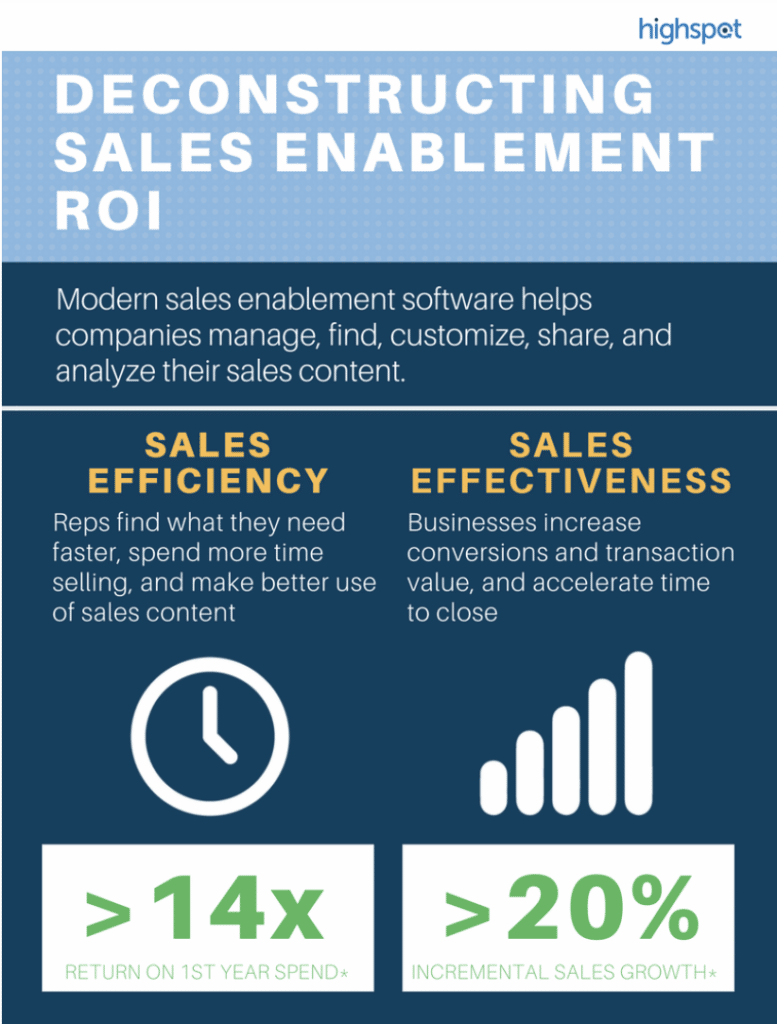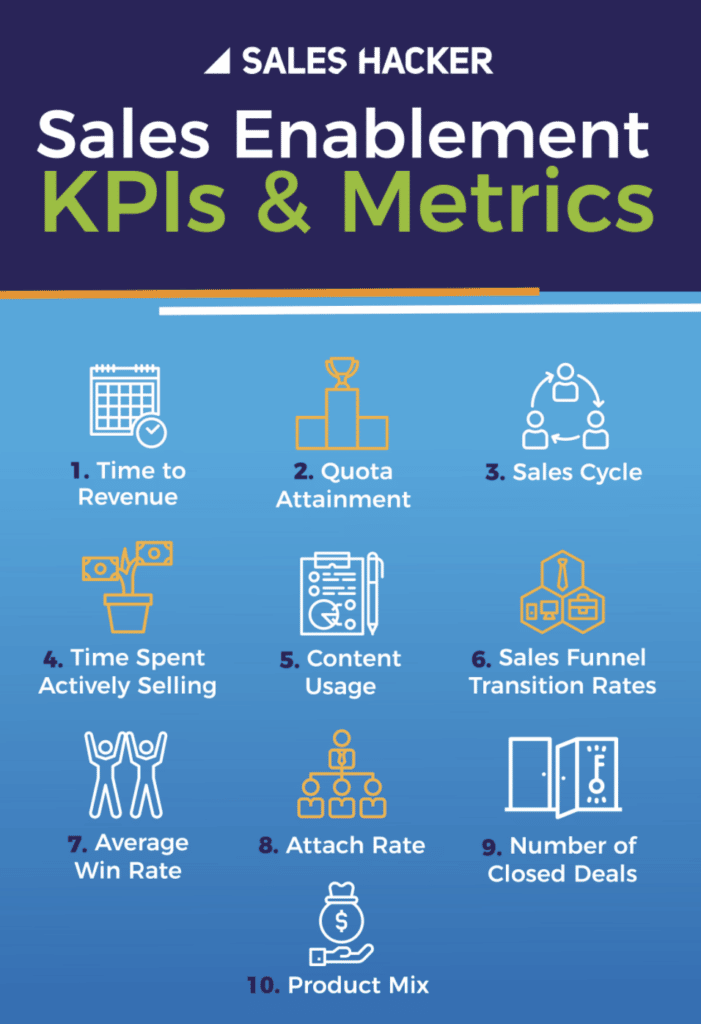Did you know that 86% of sales professionals agree that helping the customer consider all possible options and alternatives is important? In fact, companies with a sales enablement team are 52% more likely to have a sales process that’s tightly aligned with the buyer’s journey.
What does all of this tell you?
In short, the more resources you can provide your sales team with, the better — right? Absolutely. However, like any company, it has to start from the top. As the saying goes, “the most expensive cost to any company is poor leadership.” In order to institute the right processes, guidance must come from the leadership team, specifically from both the sales and marketing executives.
Here’s what I love about sales enablement and why I believe it is so critical to the success of any B2B enterprise company:
- It aligns sales and marketing efforts with the buyer’s journey. This isn’t about departments going head to head. It’s about the business and how both teams can work together to achieve the greater goals set in place.
- The focus is on adding value, not transactional sales.
- Your overall content strategy aligns with how you segment your target audience and where they are in the buyer’s journey.
- It creates efficiency and effectiveness for renewals and new sales.
To further prove my point, research shows that 59% of companies that surpassed revenue targets and 72% that exceeded them by 25% or more have defined sales enablement functions.
In today’s blog, I’m going to discuss what sales enablement is and how you can get it going for your business today to foster growth initiatives.
What is sales enablement?
According to HubSpot, sales enablement is the iterative process of providing your business’s sales team with the resources they need to close more deals. These resources may include content, tools, knowledge, and information to effectively sell your product or service to customers.
Further, sales enablement is focused on the buyer and equips sales with the right type of content that will engage, as well as convert. Therefore, the content assets you create become much more meaningful than just driving site traffic and leads, but they are there to help foster revenue generation.

Define sales and marketing goals
When you really think about it, both sales and marketing may have their own department goals, but the overarching goals are the same — to help propel a company’s growth forward.
To be more specific, an example I discussed in a previous blog post highlighted that marketers who have goals are 376% more likely to achieve success than those who don’t.
Here are examples of business goals:
- Increase revenue
- Build your brand’s authority
- Reach more prospects
- Grow profits
To tie into these business objectives, here are marketing goals:
- Gain more email subscribers
- Increase the number of visitors to your website
- Gain more social shares and followers
- Grow the number of click-throughs for your paid ads
As we keep the business goals the same, sales goals could be:
- Increase cross-sells and upsell opportunities
- Grow sales reps’ productivity
- Shorten the sales cycle
- Enhance sales processes
What I have found to be successful is aligning sales and marketing goals as a team unit — this helps both departments work together collaboratively. Rather than being competitive with finger-pointing on why leads aren’t being turned into opportunities, the focus is more on where improvements can be made as a team and where more support is needed.

This may sound easier said than done, but as I mentioned before, this type of ‘culture’ and approach has to be pushed and empowered by the leadership team. Otherwise, teams will feel disconnected and less inclined to help one another.
Know the buyer journey like the back of your hand
Long overdue are the days of trying to sell without being highly educated on ‘who’ your target personas are. More specifically, understanding ‘where’ they are digitally, the type of conversations they participate in, and the content they consume are all things that will benefit your team.
Once you know this, you can then begin to figure out the specific touchpoints that empower them to engage with your company. In other words, you know what the buyer looks like and exactly where marketing and sales will work together to inject valuable information that will build the pipeline.
Let’s quickly recap from this blog post I wrote on how to map out the buyer journey:
- 76% of customers expect companies to understand their needs.
- More than 80% of companies who prioritize customer experience are reporting an increase in revenue.
- Customers will spend 17% more for a good experience.
- Customer-centric companies are 60% more profitable than companies that aren’t.

Net net, knowing the buyer journey means that you are aware of what triggers a purchase and movement throughout the funnel. These are important data points that can be leveraged to shorten the sales cycle, be more effective and efficient, and enhance productivity with meeting business goals.

Organize and deploy sales content
Hands down, content marketing should be a part of your strategy, so looking at whether you have content that caters to the awareness, consideration, and decision-making stage is going to be critical to success. If you find that one stage doesn’t have the resources it needs to support customers, you can prioritize improvements in that area.

Having trouble creating content? SEMRush has a great Content Marketing Toolkit that helps you with everything from finding relevant topics to creating a schedule to analyzing the content’s effectiveness once it is published. Try it for free here!
Implementing lead scoring + automation to increase efficiency and track effectiveness
Tracking your activity is crucial to gaining both quantitative and qualitative data for what is working, what isn’t, and where improvements need to be made. For this very reason, I believe that implementing lead scoring and automation will be a win for any B2B company.
In other words, joining the two means that you put a stamp of importance on lead nurture and further make sure the right workflows are in place to help foster sales enablement.
Before I dive in, let’s start with some stats:
- Businesses that use marketing automation to nurture prospects experience a 451% increase in qualified leads. Nurtured leads also make 47% larger purchases than non-nurtured leads.
- Lead nurturing showed that 15-20% of the “not yet ready to purchase” opportunities converted into sales.
- Lead nurturing emails get 4-10 times the response rate compared to standalone email blasts.
What’s good about lead scoring?
This is a measurable way to attach a point system to the behavior of your target audience. In turn, you’ll be able to take further action by being more personable, personalized, and approachable with how you continue to build a pipeline and ultimately, generate sales.
Consider breaking down your lead scoring points by the following:
- Behavior such as email opens, clicks, site visits, content consumed, and forms filled out.
- Establishing a threshold by which you will be able to funnel leads into becoming SQLs/SALs. The importance of having a threshold defined is that you have a list of qualifying factors before leads are passed to sales.
- Implement score degradation — meaning, when leads do not take any sort of action it makes sense to lower the score so that you can report on active leads vs non-actives accurately, along with insightful reasoning.
- Negative scoring is going to be important as well because if, for example, someone visits your careers page, it doesn’t make sense to think they’ll become a customer as it’d more so imply they want to work for you.
- Refine and improve as you collect data and align with the buyer’s journey itself.
What’s good about automation?
Getting rid of tasks that hinder productivity, the ability for sales to prospect and generate revenue are all things that point to why automation is crucial for growth.
More specifically, check out these stats around automation:
- 76% of companies that implement marketing automation generate a return on their investment within the first year. Not only that, but 44% of them see a return within just six months.
- 80% of marketers report an increase in leads due to automation.
- 77% of marketers report an increase in conversions due to automation.
- Automated lead nurturing converts 15-20% of customers to sales
There are a lot of marketing automation tools out there, but I highly recommend Hubspot. Hubspot not only has all of the capabilities needed to organize your email workflows, but you can also schedule social media updates, run customer service functions, and more. What’s more — their email marketing is currently free. Check them out today!
That being said, I’d caution that as you implement automation, don’t ever lose sight of the role that personalization plays when it comes to truly engaging with your audience, as well as closing new sales. People buy from people, so coming across as robotic without a thoughtful response to leads can actually cost you in the long run as far as a positive ROI goes.
So make sure that you balance automation by taking a deep dive into analytics and knowing what happens with each touchpoint, then adjusting both the sales and marketing injection points accordingly.
KPIs to track
Reporting back analytical insights that can help find a better way of doing things is always a big win for any organization. In order to do this effectively, you need to know ‘why’ you’re tracking certain KPIs and metrics and how they affect your business.
It can be easy to build a laundry list of KPIs that you think should be reported on, but focus on what’s most important and impactful. In fact, here are ten identified by SalesHacker that I agree with:

These KPIs and metrics are all relevant to sales enablement. And from the marketing point of view, here’s why:
- 66% of marketing data is used to better focus on targeting offers, messages, and content.
- Companies that adopt data-driven marketing are more likely to have an advantage over the competition and increase profitability. They are also 6 times more likely to be profitable year-over-year.
- 68% of companies say improving ROI measurability is the most important goal for a data management strategy.
Wrapping it up and over to you
Get clear on how both marketing and sales will identify the sales enablement process and also the roles each will play. Make sure you use common terminology to identify the lifecycle stages of the leads because this will make your life easier, especially when reporting to a board or the entire company. This means terms like “leads, MQLs, SQLs,” etc. should be used, as they are all common industry acronyms used in the B2B world. Don’t reinvent the wheel.
Finally, be smart with where you dedicate your marketing dollars and sales time. Know where the gaps are and work together to fill those gaps so that you can do what’s best for the business while also achieving your department goals. After all, teamwork makes the dream work.
Disclosure: Please note that some of the links above are affiliate links. I only recommend products and services that I use and stand behind, and if you decide to try them, I will earn a commission at no cost to you. Doing so helps me run this blog and provide free content for you, my readers.
